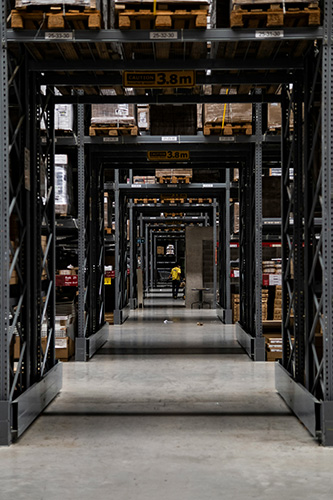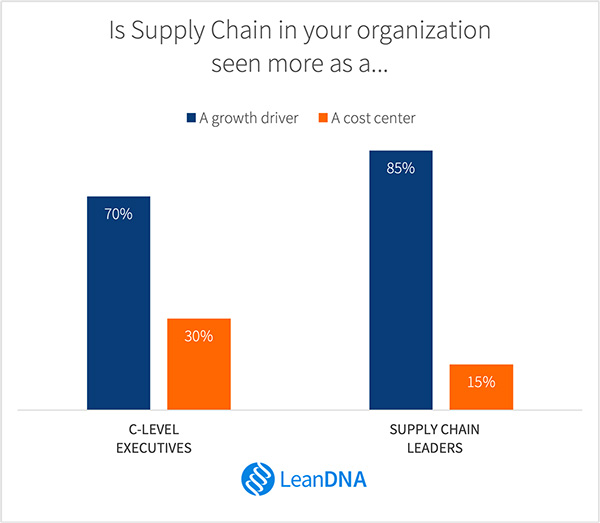New data reveals a C-suite disconnect on the strategic value of supply chains, hindering potential revenue and resilience.

By Jordan Slabaugh, Chief Marketing Officer, LeanDNA
For too long, the supply chain has often been viewed as a necessary cost center, a function focused primarily on efficiency and keeping expenses in check. However, a paradigm shift is underway, with a growing recognition that a well-optimized and strategically aligned supply chain can be a significant driver of business growth and a source of competitive advantage.
New research from LeanDNA, based on a survey of 100 U.S. C-level executives and 100 supply chain leaders conducted by Wakefield Research, illuminates this evolving perspective. While a majority across both groups acknowledge the potential of the supply chain to fuel growth, a significant disconnect persists regarding its current strategic importance and the level of investment it warrants. This perception gap represents a critical hurdle that organizations must overcome to unlock the full potential of their supply chain operations. For a wider industry outlook on the future of supply chains, see the 2025 State of Manufacturing & Supply Chain Report.
The survey data reveals a notable difference in how each group views the supply chain’s current role. An overwhelming 85% of supply chain leaders see themselves as drivers of growth, a sentiment shared by a still significant but lower 70% of C-level executives. This 15-point divergence suggests a potential misalignment in how top leadership prioritizes and values the contributions of the supply chain function. If the C-suite doesn’t fully recognize the supply chain’s strategic impact, it can lead to underinvestment, limited resource allocation, and a lack of the necessary executive attention to drive meaningful improvements.
Interestingly, despite this existing gap, there’s a sense of optimism for the future. Nearly half (46%) of C-level executives anticipate an increase in the visibility of supply chain operations within the C-suite over the next year. This growing awareness is further supported by planned increases in staffing (41%) and investments (38%) in supply chain functions. This suggests that while a perception gap exists today, there’s a growing understanding at the executive level of the critical role the supply chain plays in overall business success. The challenge now lies in translating this awareness into concrete action and fostering a deeper, more collaborative relationship between the C-suite and supply chain leadership.

The survey highlights areas where both C-level executives and supply chain leaders see eye-to-eye, particularly concerning the benefits of digital supply chain synchronization. Both groups identified enhanced supplier reliability (54% of executives, 53% of supply chain leaders), increased growth and revenue (51%, 53%), and improved on-time delivery (48%, 49%) as primary advantages of a digitally synchronized supply network. This shared understanding underscores the recognized value of leveraging technology to create a more transparent, responsive, and efficient supply chain ecosystem. When information flows seamlessly across the network, from raw material suppliers to end consumers, businesses are better positioned to mitigate disruptions, optimize inventory levels, and ultimately drive revenue growth through improved customer satisfaction and market responsiveness.

While there’s agreement on the benefits of digital transformation, the survey reveals a significant divergence in how executives and supply chain leaders prioritize the risks associated with delaying operational innovations. Executives are most concerned about increased production disruptions (53%) and a slower response to market fluctuations (43%). In contrast, supply chain leaders prioritize higher inventory costs, reputational damage, and lost revenue (all at 53%), as well as regulatory compliance risks (50%).
This difference in risk perception highlights a critical communication breakdown. If supply chain leaders fail to effectively articulate how operational delays directly translate into the risks that resonate most with the C-suite, such as production stoppages and an inability to adapt to market shifts, it becomes challenging to secure the necessary buy-in and investment for crucial improvements.
The survey data underscores this communication challenge. A striking 99% of executives and 100% of supply chain leaders agree that supply chain leaders struggle to articulate the value they bring to the company. Furthermore, a majority in both groups (55% of executives and 61% of supply chain leaders) believe that the onus lies with the supply chain side to improve this communication. This self-awareness within the supply chain community is a positive first step, but concrete strategies and training are needed to bridge this communication gap effectively.
The skepticism at the top regarding the direct link between supply chain resiliency and business growth further exacerbates this issue. While 85% of C-level executives and 94% of supply chain leaders acknowledge this skepticism within their organizations, the lack of clear and compelling communication from the supply chain likely contributes to this doubt. Exploring the connection further, delve into how to move From Resilient Supply Chains to Sustainable Growth.
Further findings from the LeanDNA survey shed light on the perceived role of artificial intelligence (AI) and proactive logistics in driving supply chain growth. There is strong consensus across both groups regarding the importance of these elements. An overwhelming majority (92% of executives, 100% of supply chain leaders) agree that AI-driven insights are essential for predicting and preventing disruptions. Moreover, optimism for return on investment (ROI) in AI and machine learning is high, with most expecting positive results within one to two years. Notably, executives are even more bullish on the immediate and near-term ROI from AI, suggesting a greater urgency and receptiveness at the C-suite level for AI-powered solutions.
Supply chain leaders are already actively embracing AI and machine learning, with 50% citing it as a top strategy for improving reliability. Other key initiatives include diversifying the supplier base (45%), implementing supply network synchronization (39%), and upgrading data infrastructure (39%). These actions demonstrate a proactive approach within the supply chain, leveraging technology to build more resilient and agile operations. For a comprehensive understanding of the foundational elements driving supply chain innovation, consider The Supply Chain Fundamentals: Process, People and Tech.
The survey also highlights the critical need for a shift towards proactive logistics planning. A significant majority of both executives (77%) and supply chain leaders (78%) believe their organization’s supply chain logistics needs to be more proactive to maximize growth. This shared recognition underscores the limitations of reactive approaches in today’s volatile global landscape. By anticipating potential disruptions, optimizing transportation networks, and proactively managing inventory, companies can enhance efficiency, reduce costs, and improve customer service, ultimately contributing to revenue growth.
The LeanDNA survey provides valuable insights into the current state of supply chain perception and the opportunities for improvement. Several key takeaways emerge:
To truly transform the supply chain from a perceived cost center to a recognized profit driver, organizations must prioritize open communication, foster a shared understanding of strategic priorities and risks, and invest in the technologies and talent necessary to build a resilient and agile supply network. By bridging the perception gap and empowering supply chain leaders to effectively articulate their value, businesses can unlock the full potential of their supply chains and pave the way for sustainable growth and competitive advantage in today’s dynamic marketplace.

About the Author:
Jordan Slabaugh is the Chief Marketing Officer at LeanDNA where she oversees marketing and go-to-market strategies to enable global manufacturers to discover the value of inventory optimization and execution solutions for today’s dynamic supply chain.
Jordan has nearly 20 years of marketing, communications, and leadership experience across disruptive Enterprise SaaS companies and global marketing agencies. She joined LeanDNA after serving as Chief Marketing Officer at Bloomfire where she led go to market growth efforts to double the company’s revenue and a successful growth investment purchase. Prior to Bloomfire, she led the Edelman Digital Marketing Southwest U.S. practice and held marketing leadership roles at high-growth SaaS companies including Wayin, Spredfast, and Convio.
Read more from the author:
“How to Speak C-Suite: A Guide for Supply-Chain Leaders,” | IndustryWeek, May 1, 2025
In this episode, I sat down with Beejan Giga, Director | Partner and Caleb Emerson, Senior Results Manager at Carpedia International. We discussed the insights behind their recent Industry Today article, “Thinking Three Moves Ahead” and together we explored how manufacturers can plan more strategically, align with their suppliers, and build the operational discipline needed to support intentional, sustainable growth. It was a conversation packed with practical perspectives on navigating a fast-changing industry landscape.